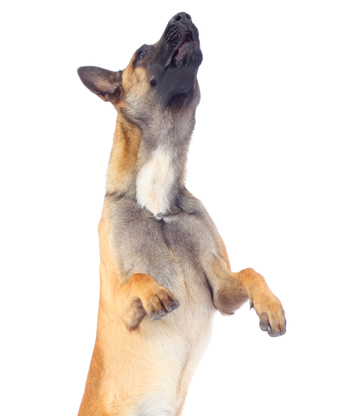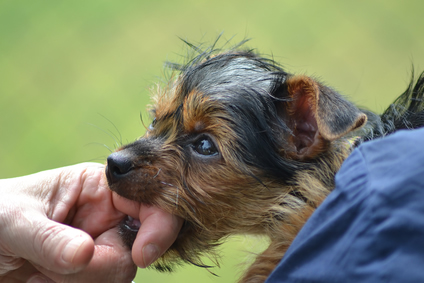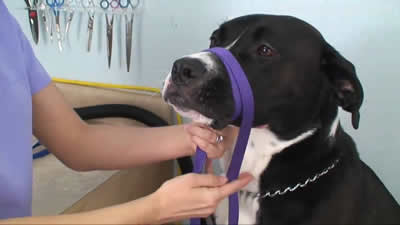Up and Coming Cujo in the Making?

Our Vitamin Experiment BACKFIRED!
September 17, 2012
Ding Dong Knock’n’Jump Dogs
November 8, 2012I received an email from a site visitor by the name of Dan who’s got a real problem with his almost 5 month old puppy. I feel it’s only right for me to share help requests with all our readers so I don’t respond privately to requests for help. I like to give everyone the opportunity to learn and to share their own ideas for helping out fellow dog owners. So, here is what I got from Dan (note that the photo in this post is not Mick!):
My 4 1/2 month old puppy Mick is very aggressive around food bowls, certain gnawing treats and thing he steals (socks, slippers). I have been hand feeding him for about 2 weeks and this has not helped. He stole a slipper from my child and bit me (requiring a doctors visit) when tried to take it back, any advice would be appreciated! Thanks.
First I’d like to say that I’m sorry you’re having these issues with the little guy. This kind of behavior is not only painful, but scary, and it’s something I feel strongly needs some definite (and immediate) behavior modifications.
The first thing that comes to mind is that he’s displaying resource guarding behavior which if not properly corrected will only get worse. Dan, you didn’t say what breed of Mick is so I have no idea how big he’s going to get. Size only matters here when it comes to just how dangerous this dog can get. Let’s face it, the bigger the dog the bigger the choppers and the more serious damage that can be done if he continues to bite.
MISINTERPRETED Protective Behavior
Resource guarding is sometimes mistaken as a dog being protective of people, toys, food, anything really. People sometimes think it’s a great thing when their dog is protective of their people, but reality is that when a dog misinterprets danger it’s nothing at all to be proud of. It’s one thing for a dog to protect their family in situations where protection is a properly-interpreted reaction. Example: the dog that attempts to fend off a burglar. Their brain has instinctively and properly interpreted this person as a danger to home and family and acted accordingly. I won’t say “acted properly” because a family dog who’s not professionally trained to protect can also be a danger. The point in this example is only that the dog interpreted danger correctly, there is real danger.
It’s a whole ‘nudder story when a dog moves into protection-mode (a.k.a. bite mode) when there is no real reason to do so. Example: a friend you love comes to visit. You and this person hug and your dog interprets this loving human behavior as your friend is hurting (not hugging) you so they bite your friend. This is not protection, this is at least one of two things and maybe a combination of both or more. 1) Resource guarding and 2) your dog was not raised in a home where this kind of human interaction was prevalent and so the dog isn’t familiar with it as being a common occurrence and gotten used to this human interaction. In other words, the dog wasn’t socialized to this kind of behavior and thus they don’t understand it for what it is. The dog misinterprets it as you needing their help and act accordingly. Not good!
A Dog’s History CONTRIBUTES TO THEIR BEHAVIORS
Not knowing if your dog was properly socialized by the breeder, his parental heritage (good breeding stock or not) if he’s a rescue who perhaps was abused in some way and/or removed from starvation circumstances or whatever caused him to take on “protecting” his food, toys etc behavior puts me at a disadvantage for a response. Whatever happens (or doesn’t happen and should) to a dog as a pup will cause them to behave accordingly to whatever happens in their lives as they grow up. Our Riley is a good example of this. He was a stray, found wandering at about six months of age. We adopted him after he’d been taken to a shelter, then transferred into rescue which was about a month later. No one has any idea how he became a stray, if he was abused, starved, why he was found wandering – did he escape a bad situation, was he dumped, did he just simply get lost? We’ll never know and this not only makes me very sad but puts us at a huge disadvantage because we have to do a lot of guesswork when it comes to his behaviors.
I in no way want anyone to interpret my comments above as being a reason to not adopt a rescue or shelter dog! It’s true you never know what you’re going to get if you don’t know your dog’s history, but that should not be a deterrent to adopting a dog who needs a loving home. We have issues with Riley that we’ll never know how or why he is like he is, but that will not stop me from adopting again in the future. Why? Because it’s the right thing to do, it’s a wonderful experience to adopt and help a dog who needs me. I understand and accept the risks. I also know unwanted behaviors can be modified.
We have issues with Nissa, too. They’re different than Riley’s but being she came from a breeder, we know her history. We didn’t know it when we purchased her that she wasn’t properly socialized, but we also didn’t now what anything about socializing dogs/puppies then either. Both our FurKids have been blessings and learning experiences for us but for different reasons.
What to do With Mick?
The first thing that needs to happen is a visit to the vet to make sure nothing is physically wrong with Mick. Always rule out medical and physical issues first or address them if they’re found.
I strongly suspect resource guarding is at the core of his issues. How he got that way is a mystery that may never be known. The important thing at this point is to modify his behavior using positive measures. I suggest you read up on resource guarding. There is an inexpensive book that was recommended to me called Mine by Jean Donaldson. It’s got some good information in it. I would not stop there, though. There’s lots of good information found by Googling.
Hand feeding may or may not help. I wouldn’t stop hand feeding but I would not expect it to be the total answer. Use it in conjunction with other measures. In my opinion, he needs to know who’s the boss and it does seem hand feeding isn’t going to do the trick on it’s own. I honestly don’t think it’s the sole answer.
I also believe resource guarding means a dog lacks confidence and/or may be fearful. I would also research ways to help a dog achieve confidence which should in turn, lessen and/or remove any fears he’s got.
TRAINING and BEHAVIOR MODIFICATION
When he’s got a toy or another object that he’s guarding, instead of just trying to remove it from him, do a swap. Give him something he can have which should take his focus off the object you don’t want him to have. You are then giving him something he wants and then taking away the other object. I don’t recommend giving him a treat, he may take this as you rewarding him for protecting the object. When you hand him the “ok” toy and he takes it, praise him lavishly. Remove the other toy silently. This isn’t a sneaky thing, it’s in my mind a way to tell him “You can only have what I give you.” and may help reinforce who’s the boss.
I would take him to a beginner’s obedience course making sure the trainer is a good one. Research the trainer first! Ask for references and then contact these people to get input from others who’ve used the trainers you’re researching. I wouldn’t stop with just basic obedience either. I would take it all the way up through an advanced course. Obedience courses not only help train your dog, but help build a bond with your dog. I personally would want to work with a trainer who’s not only a trainer but has experience in dog behavior. Remember, training and behavior are two different things!
Keep in mind if you start working with a trainer and find they’re just not the right fit for you and your dog or something just doesn’t seem right — switch to another one. Do not continue with that trainer if you don’t feel totally comfortable. Listen to your gut and proceed accordingly.
Learn positive training and positive behavior modification techniques! This all takes time and patience and lots of it! Don’t try to accomplish it nor expect to accomplish it in a few sessions. Don’t spend enormous amounts of time in single blocks either. Dog training should be done in 10 minute sessions 4-6 times a day. Puppies have a very short attention span at his age which you can work on lengthening as time passes and which should also grow some on it’s own as he gets older. Behavior modification means constant and diligent moment to moment monitoring of his behaviors and correcting them positively at the moment they occur! If you let an unwanted behavior slide once, you’re only going to have to start over. Consistency helps avoid confusion in a dog’s mind. You can’t go with taking a protected toy away once and not the next time as in “I’ll let him have it this time.” because you’re to tired or frustrated or whatever to be consistent. Mick won’t understand this and will become confused and you’ll delay progress. When you can’t monitor his behavior crate or confine him safely with safe things to keep him occupied.
I’m told ignoring unwanted behavior is supposed to help. Ignoring ONLY if it’s not a dangerous behavior requiring immediate action. I found this doesn’t work with our Riley. I’m out of behavior modification techniques for this so after years of trying to modify his over-the-top window guarding activity, we’ve decided this is one behavior he’s just not going to give up. I just am not a believer in the ignore thing but that doesn’t mean it won’t work with other dogs. What works for one dog may not work for another.
Another training method that some people have had great success with, especially for dogs who have issues is called NILIF which is the acronym for “Nothing in Life is Free.”
Patience, consistency, obedience and a positive manner of handling things should help you to help him which in turn benefits you. If you find yourself becoming impatient, crate him or confine him with something that will keep him busy for awhile, like a stuffed Kong for instance. Then walk away and get your act together really well before you interact with him again. Most adult dogs have the brain-set of about a 3 year old child. This is as good as it gets in most cases.
We wish you the best of luck and really would love it if you’d come back here to this blog post and keep us posted on yours and Mick’s progress!
Do any of you fellow dog people have any similar (hopefully successful behavior-turn-around) experiences, suggestions or other positive approaches to share for Dan’s problem with Mick?



2 Comments
thank you! Unfortunately, I called the place I adopted him from and they advised me to return the dog to them as he is too unstable to be in a household with children. They are going to try and rehab him and adopt him out to a family with no children. I am glad they are a no kill shelter! Thanks again
Hi Dan,
Thanks so much for letting us know your solution. I’m so sorry you couldn’t keep your pup but it’s wonderful that you were able to return him rather than euthanize him which is the solution all to many people resort to! This is a great lesson for people who have a similar issue with their own dog(s).